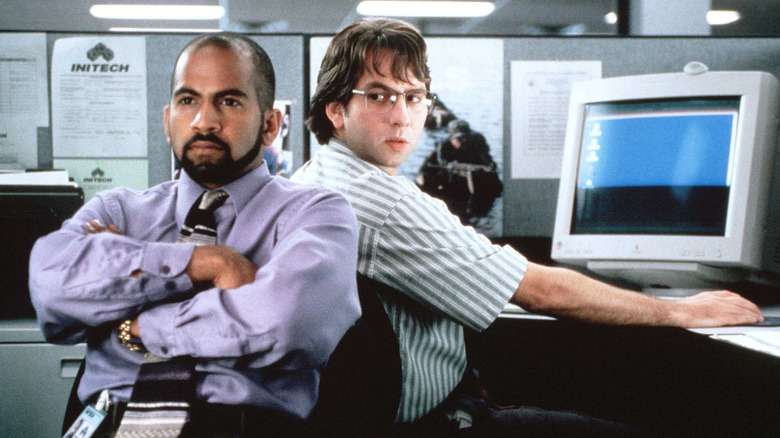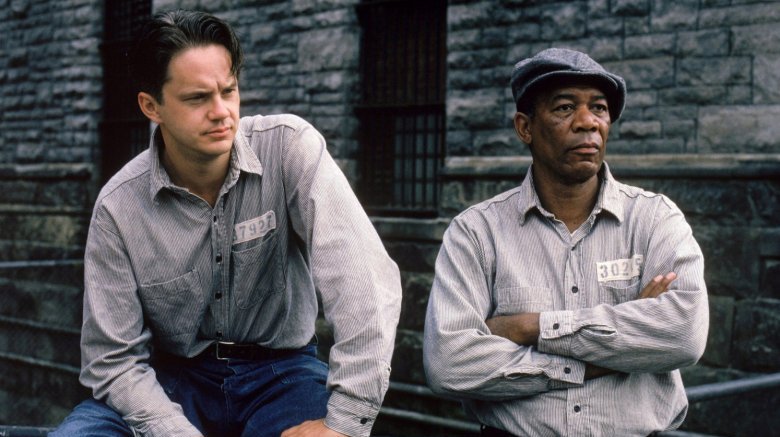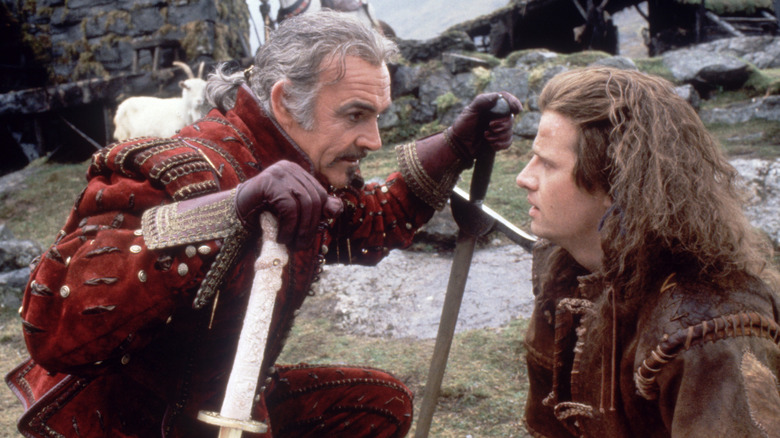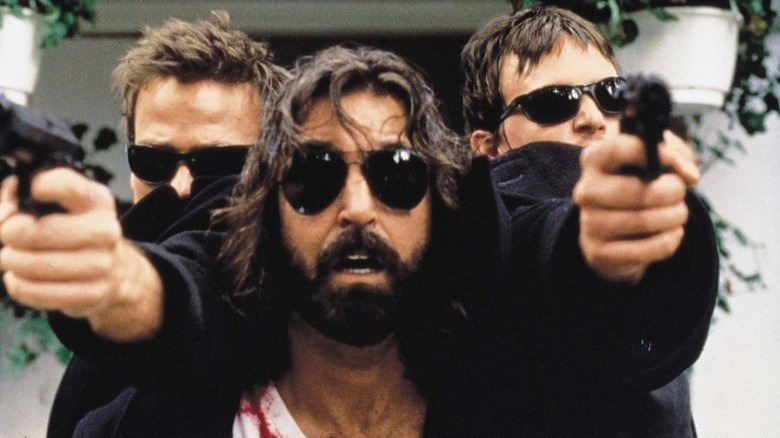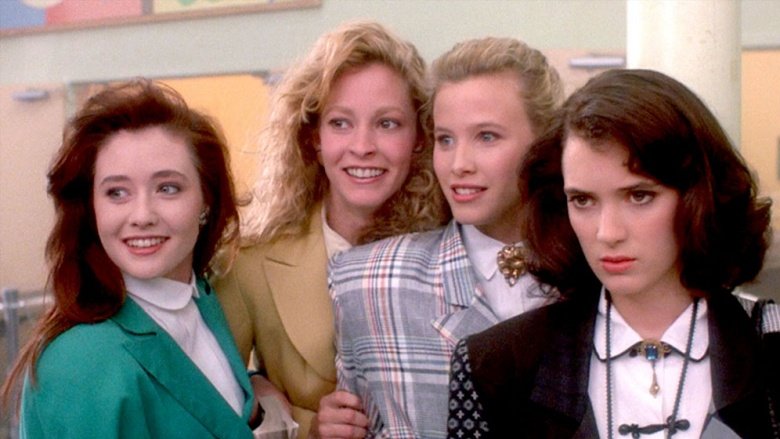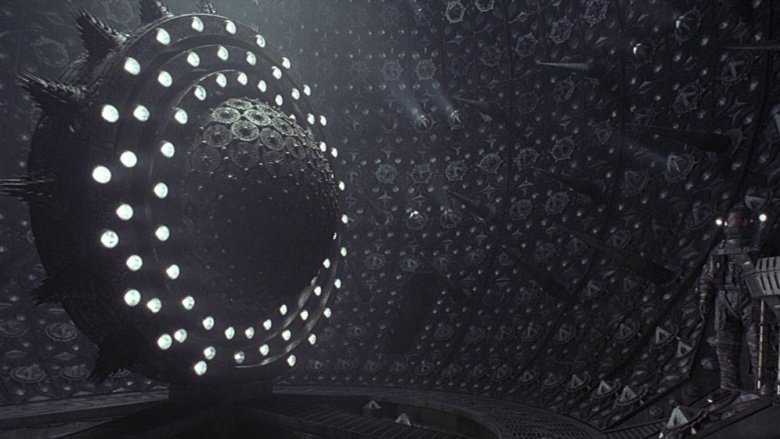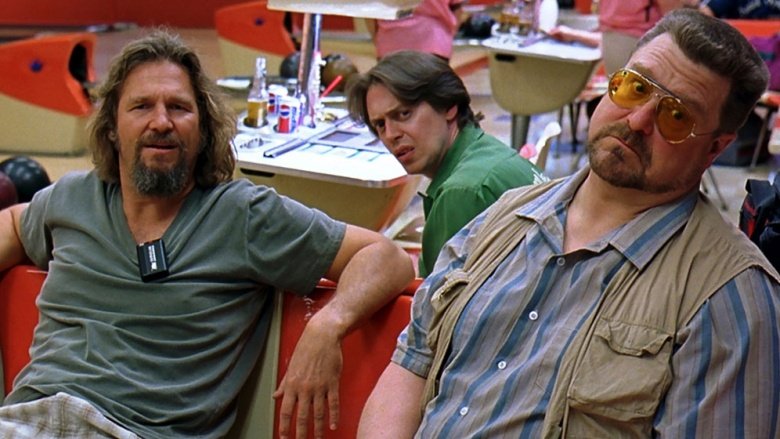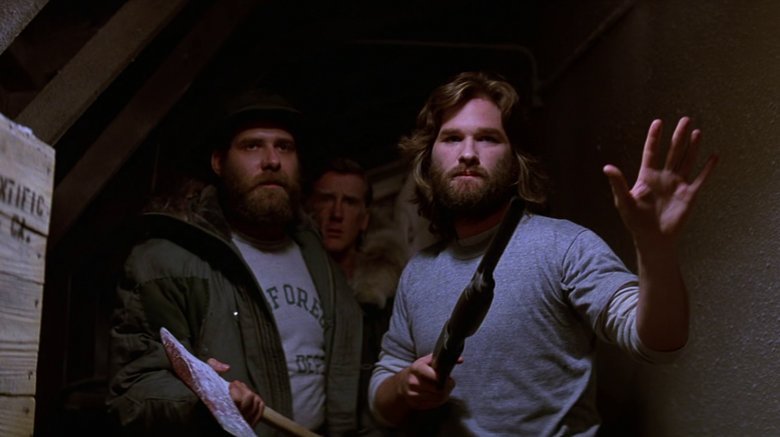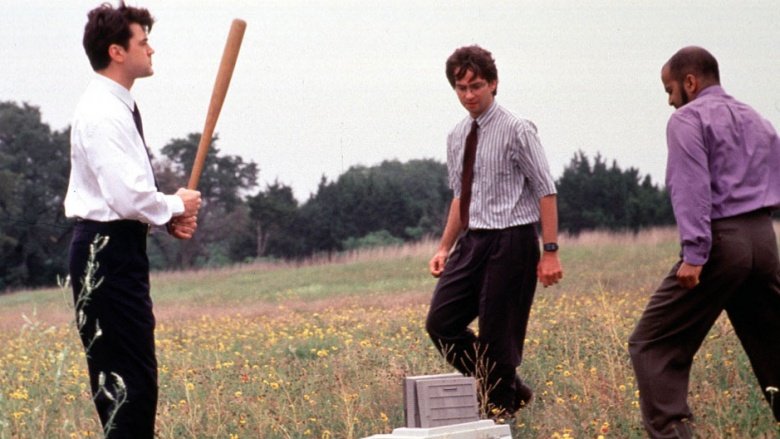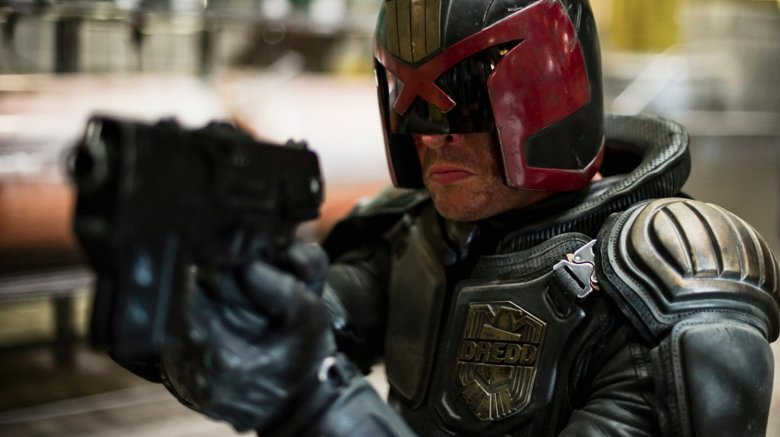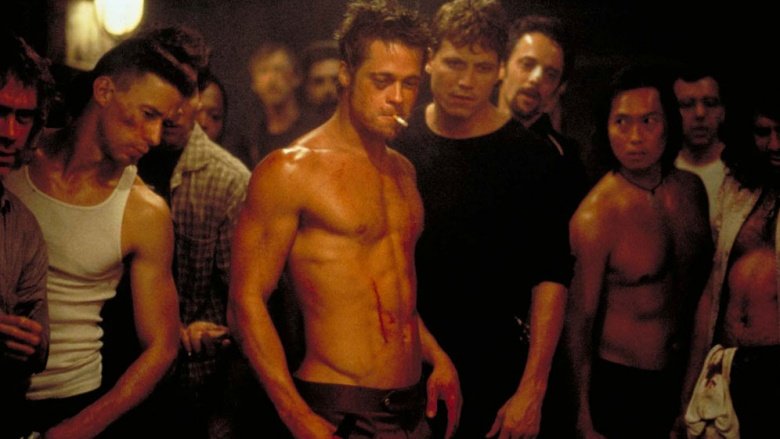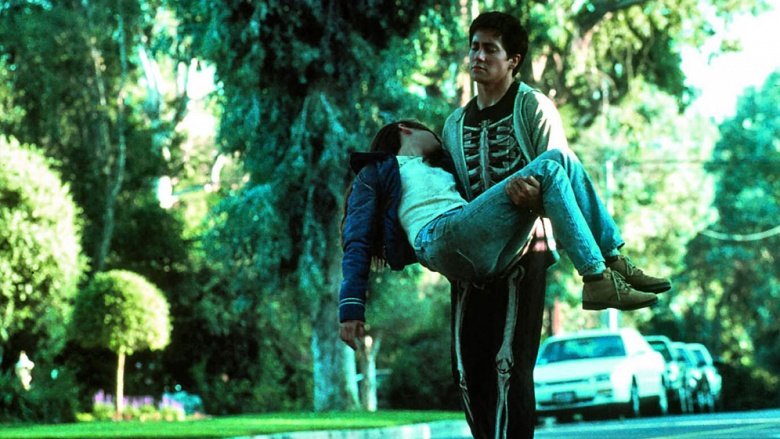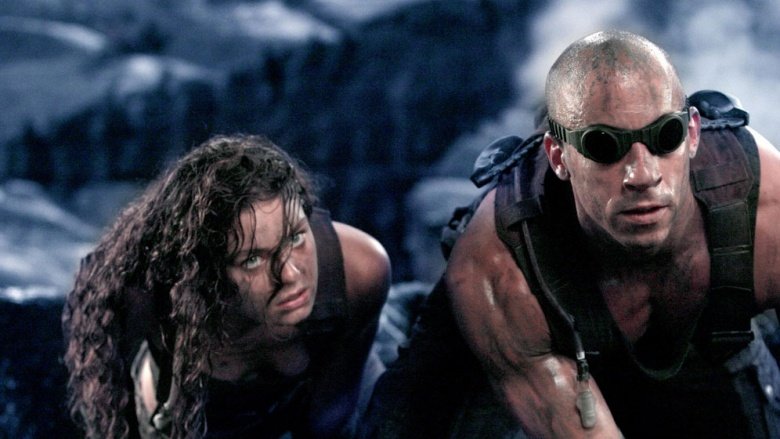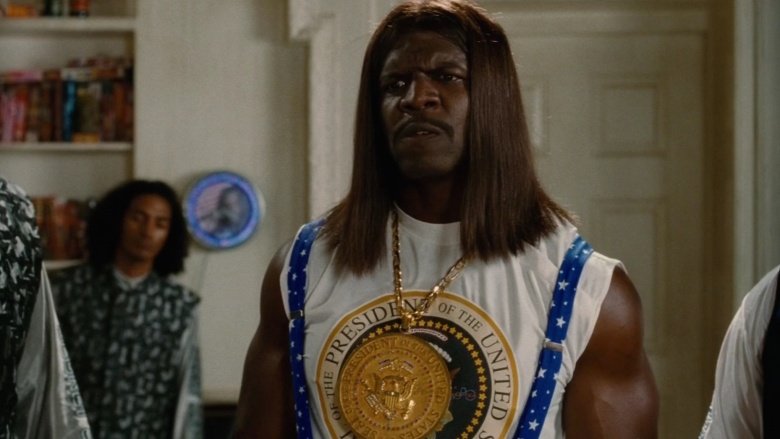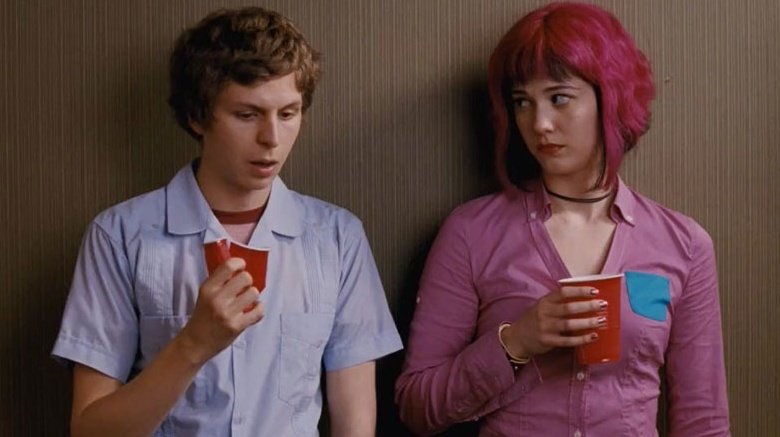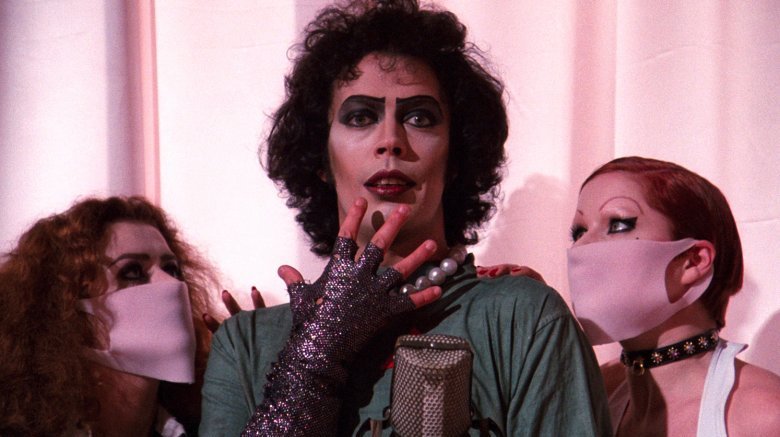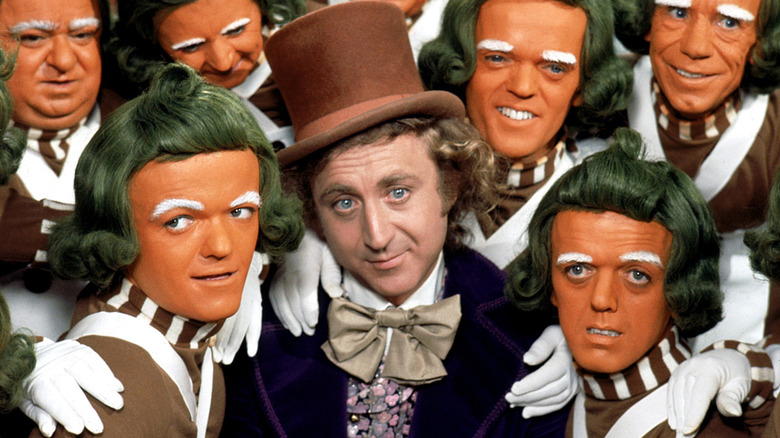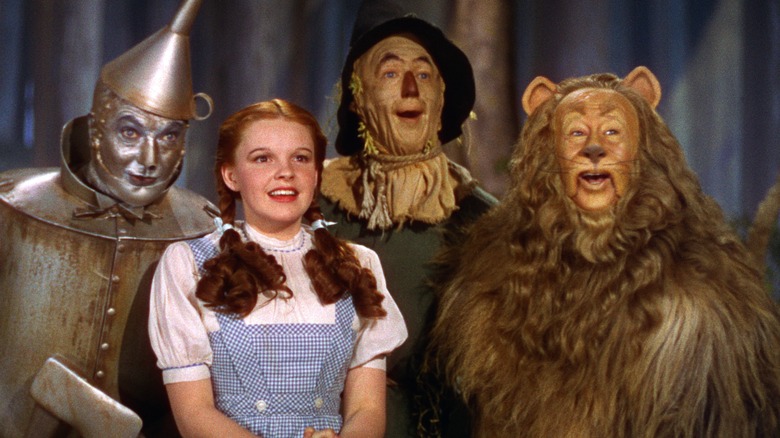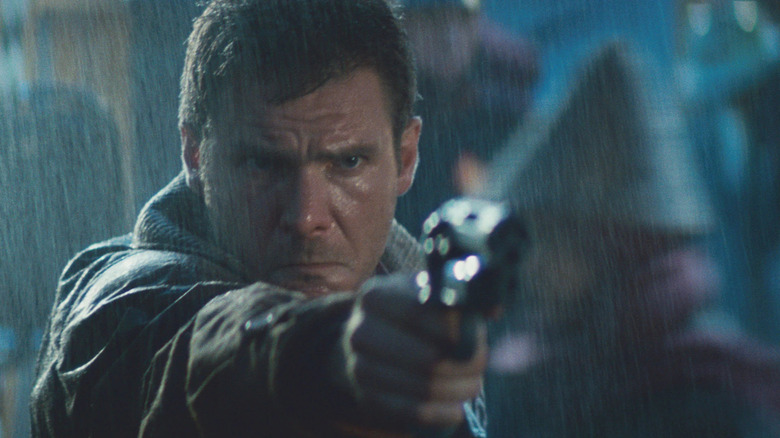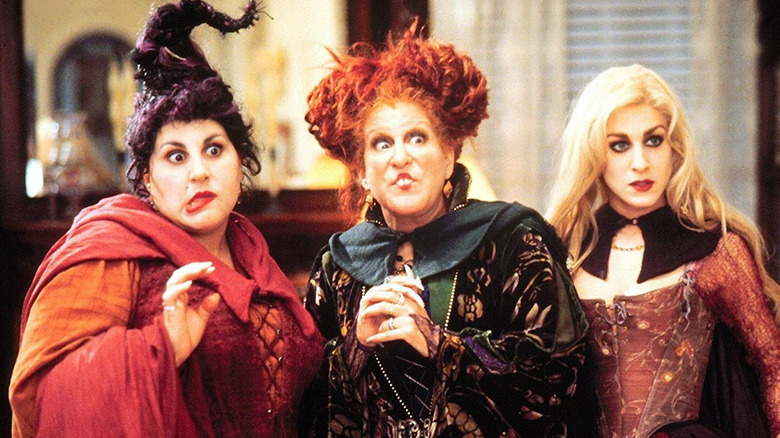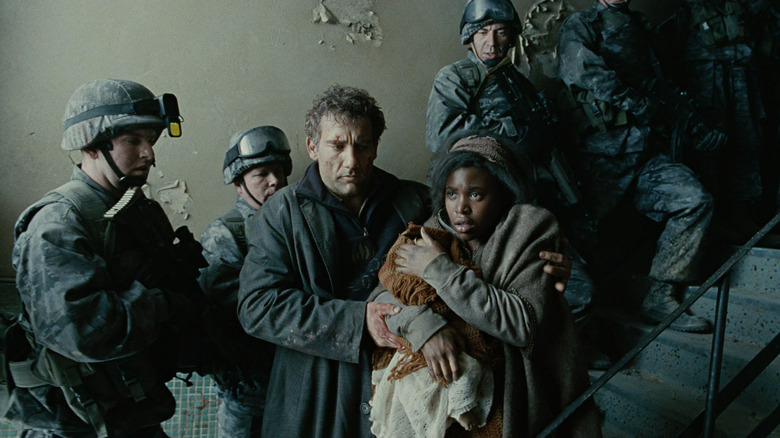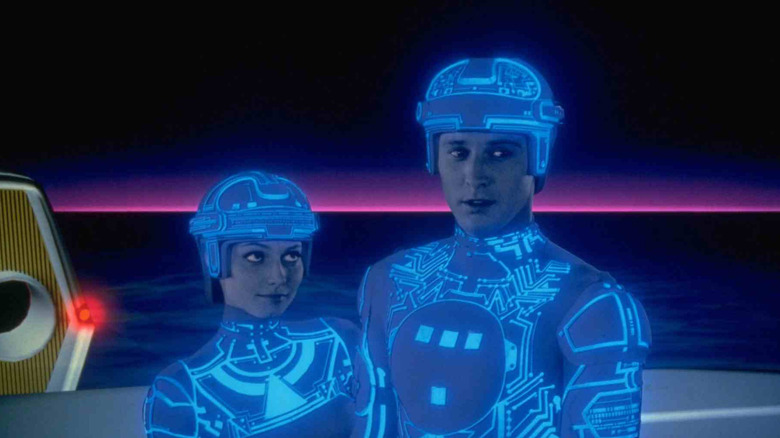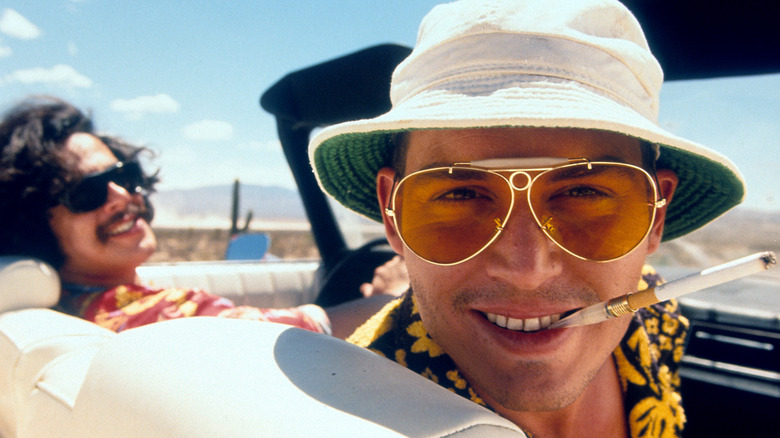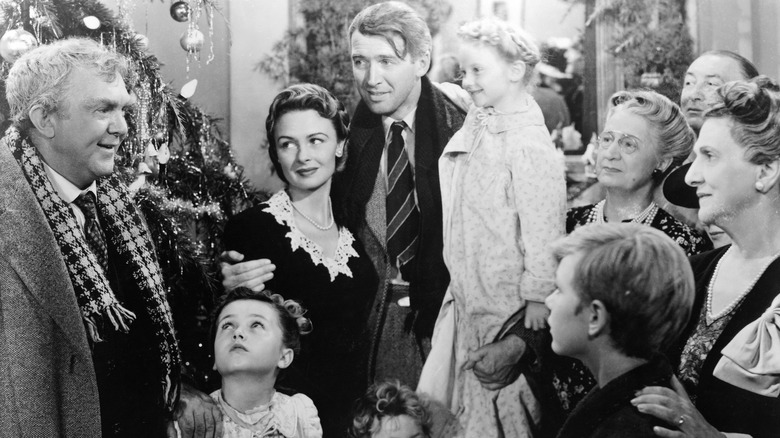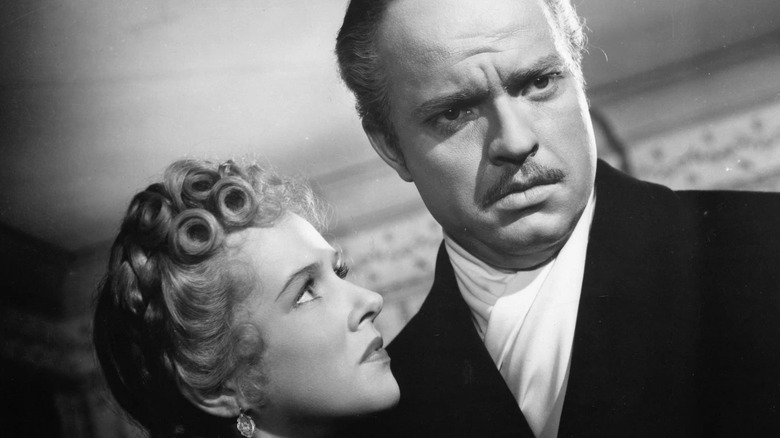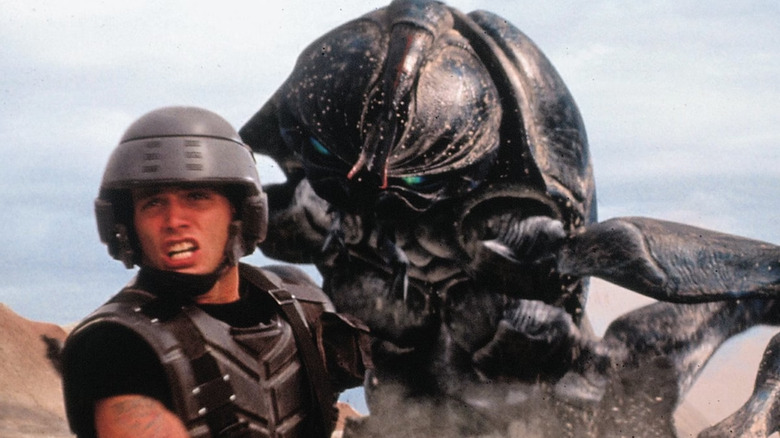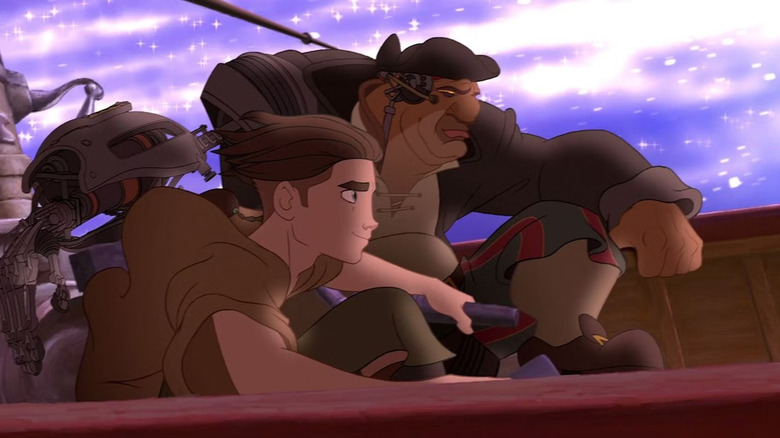Box Office Bombs That Became Cult Classics
We may receive a commission on purchases made from links.
There are all sorts of reasons why movies can crash and burn at the box office, and not all of them necessarily have to do with quality. Sure, there may be plenty of films that are appreciated by audiences as soon as they come out, but there are just as many that need a little bit of time to really connect with viewers. Every once in a while, a movie comes along that slips under the radar, only to become massively popular with fans months (or even years) later. Some are critically acclaimed, while others fall into the "so bad they're good" category, but there's one thing they all have in common: they bombed at the box office. Let's take a look back at some movies everyone thought were flops before they achieved cult classic status.
The Shawshank Redemption
It may be considered one of the all-time classic films today, but "The Shawshank Redemption" didn't attract much attention when it was first released. This wasn't due to bad reviews; on the contrary, it was praised by most contemporary critics. The main issue the film had gaining traction in theaters was the competition — it opened in only 33 theaters over its first weekend, and by the time it had a wider release in its fourth week, it was pitted in a losing battle against more popular releases like "Pulp Fiction," "The Specialist," and "The River Wild." It ended up only making $28 million in theaters, against its $25 million budget.
Although it was nominated for seven Academy Awards – albeit without any wins — and it became a success in the video rental market, it wouldn't be until 1997 that "The Shawshank Redemption" really came into its own. That year, Ted Turner acquired Castle Rock Entertainment (and the rights to "The Shawshank Redemption") and subsequently started playing it almost daily on his flagship channel, TNT. Turner's marketing ploy worked, and the movie gained legions of fans. It was added to the U.S. Library of Congress's National Film Registry in 2015.
Highlander
While today it's considered one of the best sword-and-sorcery fantasy films of the '80s, "Highlander" wasn't terribly well-received when it premiered in 1986. Despite having a lot going for it—like Sean Connery's star power and a soundtrack provided by Queen—moviegoers and critics just didn't have many positive things to say about "Highlander." It would earn $12.9 million at the box office, which didn't come close to recouping its production costs of $16 million. Once "Highlander" was released for the video-rental market, it did much better with viewers and eventually gained a cult following.
The fanbase grew so large that high demand eventually resulted in the creation of five sequel films, a live-action television series that ran for six seasons, a series of books, and even comics. That's not all—a new comic series based on "Highlander" was released in 2017, and rumors that "John Wick" director Chad Stahelski will be taking the helm for a proposed "Highlander" reboot have been circulating for years. While we have high hopes for the reboot, it's doubtful whether it will be able to beat the original. After all, there can be only one.
The Boondock Saints
If it hadn't been for now-defunct video rental chain Blockbuster, "The Boondock Saints" never would have stood a chance. The film did abysmally during its original theatrical run, primarily due to an extremely limited release. In the wake of the 1999 Columbine High School shooting, violence in films was a touchy subject in Hollywood and for theater owners. As a result, "The Boondock Saints" was only shown in five U.S. theaters upon its release, earning just $30,000 domestically. It did a little better internationally, but the total gross earnings of $411,000 didn't come anywhere close to recouping the $6 million budget.
Thankfully for the cast and for writer/director Troy Duffy, Blockbuster Video came to save the day, striking a deal with distributor Indican Pictures to distribute "The Boondock Saints" on video as a "Blockbuster Exclusive." The movie soon gained a massive cult following, bringing in over $50 million in DVD/Blu-ray sales. It became so popular that it spawned a sequel in 2009, and rumor has it that a television series based on the Saints is somewhere in the development process.
Heathers
If you're a child of the '80s, you've likely seen this black comedy film directed by Michael Lehmann — but we can almost guarantee that you probably didn't see it in theaters, because ... well, to be honest, not many people did. "Heathers" boasted some major young talent, including Winona Ryder and Christian Slater (not to mention future "90210" star Shannen Doherty), but in spite of the cast's efforts, it performed abysmally at the box office, only earning $1.1 million in theaters against a reported $3 million budget.
After its VHS release in 1989, the home rental and sales market transformed "Heathers" into a cult classic, with multiple special edition DVD and Blu-ray versions released over the ensuing years. Since then, it has earned a short-lived — and much-maligned — television reboot that aired in 2018, as well as a stage musical that was performed Off-Broadway and on the West End in London.
Event Horizon
Not even the combined star wattage of Sam Neill and Laurence Fishburne could keep "Event Horizon" from sinking at the box office. This suspenseful sci-fi film received unfavorable reviews when it was first released, and earned an abysmal $26.7 million at the box office—losing over $30 million along the way. While theatrical audiences were turned off by the prevalent gore in the film, it eventually found its niche among sci-fi fans on the home release market.
Our only regret is that we will likely never see the director's cut: the footage removed from the theatrical version was reportedly scrapped by the studio, and the only remaining copy is on VHS. Fans have new "Event Horizon" content to look forward to, though. In 2019, it was announced in Variety that Amazon was in the process of developing a follow-up mini-series of the science-fiction cult classic.
The Big Lebowski
When "The Big Lebowski" hit the big screen in the United States, it was met with a lukewarm response from mainstream audiences. The quirky comedy only grossed $17 million domestically, which barely covered the $15 million budget. However, the Dude went on to gross another $28 million internationally and grew into a legend after arriving on home video. It became a defining role for star Jeff Bridges, has been the focus of persistent sequel rumors, and even spawned its own annual festival, the Lebowski Fest. Nowadays, you'd be hard-pressed to find many film fans or general audiences without at least some knowledge of "The Big Lebowski" and its memorable lead character.
The Thing
John Carpenter's "The Thing" faced an uphill battle: Steven Spielberg's "E.T. the Extra-Terrestrial" had been released just two weeks before, and it debuted the same day as Ridley Scott's "Blade Runner". As a result, "The Thing" only made $3 million during its opening weekend and went on to gross only $19 million during its theatrical run. Compared with a budget of $15 million and poor contemporary reviews from critics, "The Thing" was a definite failure for Universal Pictures.
But as would later prove to be the case with Carpenter's "Big Trouble in Little China" and "They Live," a disappointing theatrical run wasn't the end of the road for "The Thing." It would eventually find a major following among horror fans, becoming yet another cult classic on Carpenter's resumé. It's been named among the scariest films of all time and has spawned numerous other works—including a novel, comic books, a video game, and an ill-advised 2011 prequel (directed by Matthijs van Heijningen Jr.) that had no chance of standing up to the original.
Office Space
"Office Space" marked "Beavis & Butt-Head" creator Mike Judge's first foray into live-action filmmaking, and he had to contend with Fox studio executives trying to butt in on the production process. While the movie only barely recouped its budget at the box office, the home market was another story completely. By 2003, it had racked up a whopping 2.6 million in combined sales between its VHS and DVD releases, and that number has only continued to climb. "Office Space" resonated with white-collar workers across the United States, and has only grown in relatability in recent years. Although we'd love to see a modern take on the film — maybe one that satirizes the current push to get employees back in the office after the COVID-19 pandemic — it doesn't seem that Judge has any plans to tackle a sequel at the moment.
Dredd
Even though it essentially had a built-in fanbase from the original "Judge Dredd" comic books and the 1995 film starring Sylvester Stallone, 2012's reboot "Dredd" didn't perform well at the box office. Overall, the movie managed to pull in just $41 million from theatergoers around the world, against a budget of $50 million. It's hard to understand exactly why "Dredd" bombed; the reboot had a positive critical reception, while 1995's "Judge Dredd" was panned by critics and still managed to earn over $110 million. It seems that at least some of the blame can be placed on the marketing for the movie. While reports indicate that over $25 million was spent to advertise "Dredd," lead actor Karl Urban told Den of Geek that there was "zero audience awareness" about the movie when it was released.
Whatever the reasons for its theatrical failure, nothing could keep Dredd down once it hit the home market, where it became an instant success. "Dredd" sold 650,000 copies the first week it was available on DVD and Blu-ray. Now a cult favorite with sci-fi and action fans, "Dredd" may have finally gained the street cred it needed to get a sequel — which is reported to be in the works as a television show.
Fight Club
Based on a novel by Chuck Palahniuk, "Fight Club" suffered from interference at the studio, where execs fretted over test screenings, bumped the release date repeatedly, and ultimately ended up tinkering with the marketing campaign over director David Fincher's wishes. After all that fretting, the results were a letdown for Fox: Reviews were middling and against a budget of $63 million, "Fight Club" only earned $37 million domestically in theaters. While the losses were mostly made up by international box office sales, it wasn't until the movie arrived on DVD that it really came into its own. Unfortunately, this newfound success came with a hefty price: Many fans take at face value the toxic masculinity that the film intended to examine with a critical lens.
Donnie Darko
Filmed in just 28 days by debuting writer-director Richard Kelly, "Donnie Darko" is a psychological horror/sci-fi film that tells the story of the title character as he searches for the cause and meaning of his apocalyptic visions. Filmed with a small budget of only $3.8 million and nearly sent straight to home video by the distributing studio, "Donnie Darko" debuted with a limited theatrical release on only 58 screens domestically; Its international release was delayed for almost a year because of the September 11 attacks. Theatrical audiences in the U.S. weren't quite sure what to make of the movie's odd aesthetic and mind-bending plot, but it found a more receptive audience overseas, and after its arrival on DVD, it gained cult status. (The sequel centering on Donnie's younger sister Samantha, however, is another story.)
The Chronicles of Riddick
In "The Chronicles of Riddick," Vin Diesel returned to the silver screen as Richard B. Riddick, a character who first appeared in 2000's "Pitch Black." After the success of the first film, Diesel jumped on board as a producer for the sequel. Initially, "Chronicles of Riddick" was panned by most critics, and Diesel was even nominated for a Razzie Award for worst actor. The film made $115 million in theaters worldwide, which seems like quite a lot — until you realize the budget was around $120 million. Despite the poor reception in theaters, "Chronicles of Riddick" latched on with home viewers, who helped the movie gain back some of that budget shortfall with DVD sales. The fanbase eventually helped a third sequel, titled "Riddick," make its way to theaters in 2013 — the latest installment in a once-unlikely franchise that's spread to encompass books, action figures, animated features, and even video games.
Idiocracy
Mike Judge must have some sort of cult movie magic about him. Making his return to feature film directing after the frustrations of 1999's "Office Space," Judge used "Idiocracy" to show viewers a horribly prescient vision of our future, filled with massage-parlor coffee shops and an expletive-laced, monster truck rally-esque system of law. Unfortunately, the movie never had a prayer after the studio mothballed it for years, failed to market it, and only released it to 130 theaters. While "Idiocracy" only made $495,000 at the box office, it became another of Judge's home video sensations, earning another $9 million in DVD rentals alone. And every year that goes by, "Idiocracy" becomes a more biting social satire.
Scott Pilgrim vs. the World
With "Scott Pilgrim vs. the World," Universal Pictures took a chance on an action-comedy adaptation of a graphic novel series about the romantic travails of the titular slacker musician (portrayed by Michael Cera) on his quest to defeat — video game-style — the former beaus of his would-be lady love (Mary Elizabeth Winstead). Despite mostly positive critical response and several accolades for the movie, "Scott Pilgrim vs. the World" faced an uphill marketing battle: The studio struggled to clearly communicate the storyline during its publicity campaign, and Cera's post-"Juno" hot streak had fizzled after a string of duds like the lethal "Year One." As a result, "Scott Pilgrim vs. the World" failed to earn enough money to recoup its production budget. Things changed in the home video market, however, where the movie went on to sell nearly 200,000 copies in its first week.
The Rocky Horror Picture Show
It may be the movie with the longest-ever theatrical run, but "The Rocky Horror Picture Show" most definitely bombed during its initial release. Although it was based on a popular stage musical, the film adaptation only earned $21,245 in its opening weekend. Disappointed with the premiere, the studio pulled the movie from several other locations around the country. For most films, that would have been the end of the story. But one Fox advertising executive had a brilliant idea: Start showing "The Rocky Horror Picture Show" at one of the popular "midnight shows" at the Waverly Theatre in New York City, where it proved an instant hit.
After several months of late-night showings with a party-like atmosphere, one of Waverly's "Rocky Horror" regulars — mild-mannered kindergarten teacher Louis Farese — started to shout improvised lines back at the screen. The midnight showings soon spread to other theaters around the country, along with the habit of shouted audience "call-backs." Eventually, dedicated fans began to form "shadow-cast" performance troupes — acting out the film in costume on stage as the movie plays on the big screen behind them. Within a year, "Rocky Horror" went from a box-office bomb to a cult sensation that's still going strong more than 40 years later.
Willy Wonka & the Chocolate Factory
The bizarrely charming "Willy Wonka & the Chocolate Factory" wasn't a hit when it came out in 1971. Although it's considered a classic now, it only earned about $4 million upon its release, which isn't great, considering its $3 million budget. This may have happened because it was marketed as a family-friendly film, yet had moments that could be scary for children, like the creepy tunnel scene and the kids getting harmed in various ways. Roald Dahl, the author of the 1964 book the film was based on, was outspoken about his dislike of the film adaptation. He didn't like the songs, the numerous changes to the plot, or how Willy Wonka (Gene Wilder) seemed to be the main character rather than Charlie Bucket (Peter Ostrum).
The movie became much more popular after being re-released in 1996 and coming out on home video. It's now considered one of Gene Wilder's most iconic roles — and that's saying a lot, since he was in many other great movies as well. Its popularity led to the 2005 remake "Charlie and the Chocolate Factory," starring Johnny Depp, and the prequel "Wonka," which stars Timothée Chalamet and is set for release in December 2023.
The Wizard of Oz
It's hard to believe that "The Wizard of Oz," one of the most beloved musicals of all time, bombed at the box office, but it's true. When it was released in 1939, it made a mere $3 million against a production and distribution budget of over $4 million. People just weren't rushing to the theatres to see a farm girl explore an alternate world with a lion, scarecrow, and tin man. On the bright side, it mostly earned positive reviews and went on to win two Academy Awards: one for best original song ("Over the Rainbow") and the other for best original score.
The film started making profits after it was re-released in 1949, thanks in part to Judy Garland being a much bigger star by then. It earned even more money after it was re-released in 1955, aired on TV beginning in 1956, and came out on home video in 1980. Now it's an undeniable classic and has made around $25.6 million overall — not bad at all, considering its original budget. The film has also inspired multiple remakes and spin-offs, including the 2013 film "Oz the Great and Powerful," starring James Franco and Mila Kunis, and the upcoming 2024 film "Wicked," starring Cynthia Erivo and Ariana Grande.
Blade Runner
The 1982 film "Blade Runner" has made a huge impact on cinema and is regarded as a science fiction masterpiece. Despite its current reputation, however, it initially had a disappointing box office performance, only grossing about $26 million that summer on a $28 million budget. To make matters worse, many people who saw the movie didn't have great things to say about it. Some viewers thought the pacing was slow and others didn't like how grim the story was.
It is a niche film, so it makes sense that the general public didn't love it. Many commercially successful films have simple plots and tons of action, but director Ridley Scott wasn't interested in going that route while making this movie: He wanted to make an artistic film with thought-provoking themes. "Blade Runner" also had stiff competition when it was released, since "E.T. the Extra-Terrestrial," "Star Trek II: Wrath of Khan," and "Conan the Barbarian" all came out around the same time.
As time went on, "Blade Runner" gained a cult following, many different versions of the film were released, and it ended up earning about $39.5 million. Its popularity inspired the 2017 sequel "Blade Runner: 2049," starring Ryan Gosling and Harrison Ford, the 2021 animated series "Blade Runner: Black Lotus," starring Jessica Henwick, and the upcoming live-action series "Blade Runner 2099."
Hocus Pocus
Many of us grew up watching "Hocus Pocus" every Halloween, so it might come as a surprise that the cult classic wasn't an instant hit upon its 1993 release. The film grossed about $45 million, so it managed to recoup its $28 million budget, but not by much, especially compared to other Disney's other films. For instance, Disney released "The Santa Clause" the following year, which made almost $200 million on a $22 million budget.
"Hocus Pocus" should've been released around Halloween, but instead, it was released in July — a decision that essentially set it up to fail. It also wasn't marketed very well and faced serious competition from "Jurassic Park" and "Free Willy." Disney had thought a summer release would be better for the movie since kids would be out of school. From a practical standpoint, a July release would mean that it wouldn't compete with their other spooky film, "The Nightmare Before Christmas," set to come out in October, so it'd be a win-win for the studio. Oh, how wrong they were.
Despite its underwhelming premiere, "Hocus Pocus" eventually put a spell on viewers. It started airing on TV every Halloween in the late '90s and gained more fans after its 2002 DVD release. It was re-released in theatres in 2020 and the sequel, "Hocus Pocus 2," came out in 2022, starring the original trio of actresses as the Sanderson sisters.
Children of Men
"Children of Men" has powerful themes about the resilience of the human spirit that are just as relevant now as they were when the film came out in 2006. Unfortunately, the film wasn't able to recoup the cost of production, earning around $70.5 million on a $76 million budget. One reason for this was the film's limited theatrical release, which meant many people couldn't see it even if they wanted to. On top of that, Universal Pictures didn't market the movie successfully. They weren't sure what demographic wanted to see a bleak, dystopian sci-fi movie devoid of flashy laser guns and flying spaceships, and their promotional campaign reflects their uncertainty.
On the plus side, "Children of Men" has gotten the recognition it deserves. The film was met with glowing reviews from critics upon its release and BBC Culture has since ranked it #13 in their list of the best films of the 21st century. It has won multiple awards as well, including best science fiction film at the Saturn Awards and best cinematography at the BAFTA Awards.
Tron
"Tron" was way ahead of its time, leading to underwhelming box office numbers upon its 1982 theatrical release. It grossed about $33 million on a $17 million budget, so it wasn't a complete financial failure, but the profits weren't nearly impressive as some of Disney's other movies. For comparison, "The Fox and the Hound" came out the year prior, earning over $63 million on a $12 million budget.
"Tron" wasn't an instant success for a number of reasons. First, it had a confusing premise, when you consider the fact that the internet wasn't well-known among mainstream audiences, so viewers may not have been familiar with the idea of an avatar representing someone in a virtual space. The movie was also very expensive to make, due to its groundbreaking special effects that combined CGI, innovative lighting techniques, and live-action footage.
The movie struggled to compete against the massively popular "E.T. The Extra-Terrestrial" and "Star Trek II: The Wrath of Khan." It was met with mixed reviews, with some critics praising its special effects while others complained that the story fell short. Ultimately though, people came to love "Tron" as time passed and they became more familiar with the idea of a digital world. The sequel "Tron: Legacy" was released in 2010, followed by the animated series "Tron: Uprising" in 2012.
Fear and Loathing in Las Vegas
"Fear and Loathing in Las Vegas" is one of those movies that people either love or hate. Unfortunately for those who worked on the film, most people hated it when it came out in 1998. It earned a mere $13.7 million, failing to break even on its $18.5 million budget. The movie's style of storytelling isn't for everyone; it's chaotic, trippy, and confusing at times. This is meant to mimic the altered state of mind that the characters are in due to their heavy drug usage, but some audiences find it more overwhelming than entertaining.
The movie gained a cult following after it was released on DVD. Johnny Depp, who starred as Raoul Duke, had since skyrocketed in popularity in the intervening years, especially after portraying Captain Jack Sparrow in the 2003 film "Pirates of the Caribbean." This may have helped "Fear and Loathing in Las Vegas" become more popular as well. Aside from that, movies using the altered stream-of-consciousness style had become more mainstream, so it wasn't as jarring for viewers anymore. This allowed audiences to admire the film for its unique style and underlying themes of self-indulgence, chasing the American dream, and disillusionment.
If you or anyone you know needs help with addiction issues, help is available. Visit the Substance Abuse and Mental Health Services Administration website or contact SAMHSA's National Helpline at 1-800-662-HELP (4357).
It's a Wonderful Life
When it comes to Christmas movies, "It's a Wonderful Life" is a go-to for many families year after year. However, when the movie came out in 1946, it was such a failure that it led to director Frank Capra's production company shutting down. The film originally had a budget of about $2 million, but multiple script rewrites and changes to the crew inflated the cost of production to about $3.7 million. It earned a measly $3.3 million upon its 1946 release and garnered mixed reviews.
The film was released the year after World War II had ended, which contributed to its unimpressive box office numbers. American audiences were not necessarily in the mood for a supposedly inspirational holiday movie that eventually has a happy ending, but also features more than a few shockingly dark moments. The film also came out around the same time as "The Best Years of Our Lives," which blew it out of the water.
"It's a Wonderful Life" didn't become popular until decades later. Its copyright ended in 1974, so TV studios started airing it every Christmas since they didn't have to pay any royalties. People began realizing how good of a film it is, and the rest is history.
Citizen Kane
Countless films have faded into obscurity over the years, but "Citizen Kane" has remained highly renowned for decades. It wasn't always so popular, though. The film earned about $1.6 million against its $800,000 budget when it came out in 1941, so it wasn't considered a success, despite receiving many positive reviews for its outstanding performances and cinematography.
The main reason for the disappointing turnout was all the controversy surrounding the film prior to its release. Powerful publishing tycoon William Randolph Hearst thought the main character, Charles Foster Kane (Orson Welles), was based on him, so he did everything he could to stop the film from being released. As a result, the film had a delayed and limited release, which severely impacted its box office performance. It did, however, win best original screenplay at the Academy Awards.
"Citizen Kane" gained a lot more praise after it was re-released in the 1950s and began airing on TV. As the years went on, it became a bona fide cult classic, influencing many other films and earning its place in cinematic history.
Starship Troopers
When "Starship Troopers" came out in 1997, its marketing made it seem as though it would be a goofy science-fiction adventure rather than a satire of the military-industrial complex. That led to the movie earning a mere $54.8 million during its domestic release, failing to recoup its $105 million budget. The movie didn't have a star-studded cast that would draw audiences in; the lead actors were Casper Van Dien and Denise Richards, who weren't big names at the time. The film was also quite different from the 1959 novel by Robert Heinlein that it was based on, which threw some people off. The book depicted military life in a positive light, and audiences may have assumed the film would do the same — nothing could be further from the truth. What really put the nail in the coffin, though, was the film's release date. It came out just a few months after "The Fifth Element" and "The Lost World: Jurassic Park" and a month before "Titanic," so it was competing for viewers left and right.
Although the film was vastly misunderstood upon its release, it eventually gained popularity among a niche audience. Fans loved that the film made fun of military propaganda and fascism, drawing parallels between the story and real life. It eventually went on to gross $121 million overall.
Treasure Planet
"Treasure Planet" was packed with adventure, quirky characters, and beautifully animated scenes, so you'd think it would have been a box office hit — but that wasn't the case. The film cost a whopping $140 million to make and grossed about $110 million, costing Disney a pretty penny after its 2002 release.
Unfortunately, the movie was doomed to fail, since it was set for release around the same time as "Harry Potter and the Chamber of Secrets," "The Santa Clause 2," and "Die Another Day." Disney also didn't market the film very well and its target audience was unclear. It was promoted as a family film, but the plot is a bit too complicated for children, the main character is a moody teenager, and there are no princesses or musical numbers. At the same time, its perceived status as a kids' movie kept the older crowd from flocking to theatres to see it. As if all that wasn't enough, the animation style was noticeably different from Disney's other films, which may have thrown viewers for a loop.
Although the film garnered mixed reviews and tanked at the box office, people started recognizing its unique charm after it came out on DVD. They came to love the film's mature themes, relatable characters, and stunning animation style that mixed hand-drawn frames with CGI.
The Iron Giant
The animated family film "The Iron Giant" has gained a cult audience since its release in 1999, but it was initially a huge commercial failure. The movie only made about $31.3 million against its $50 million budget due to Warner Bros. marketing it so poorly. They had recently released the animated film "Quest for Camelot" and it bombed at the box office, so they weren't willing to spend a lot of money promoting another animated movie. As a result, hardly anyone knew "The Iron Giant" was even coming out.
Despite all of that, the movie was loved by those who did go see it. Fans praised the film for its beautiful animation, likable characters, and the balance of funny and heart-wrenching moments. By the time it was released on DVD, it had already established a cult following, but being available on home video helped it reach an even wider audience.
